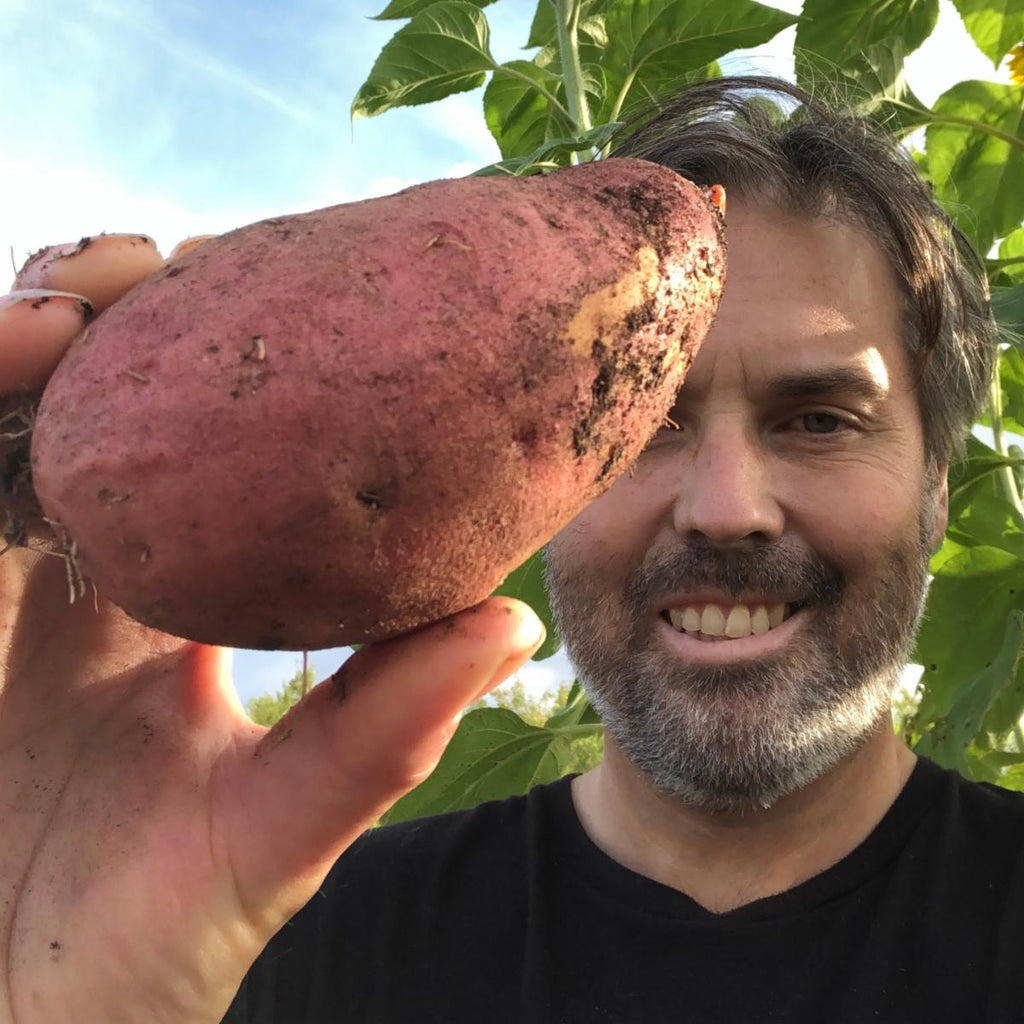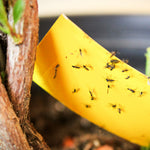Radiance sweet potatoes did so well this year!
The gorgeous weather is keeping gardeners busy with ongoing flushes of tomatoes and peppers to process. This may mean leaving root veggies on the sidelines while the priority for harvest goes to the quickly perishable fruiting crops. But, it does leave some wondering, "how long can I leave root crops in the ground?"
In today's blog, we'll review guidelines for maximizing harvest as well as increasing the storage life for sweet potatoes, potatoes and onions.
Sweet potatoes (Ipomoea batas)
Sweet potatoes, sometimes incorrectly called yams, are very different from standard potatoes. They thrive on heat and grow as ground-hugging vines that can yield massive tubers in fall. Whereas regular potatoes are planted from "seed" tubers in early to mid-spring, sweet potatoes will only yield well if planted as rooted or unrooted slips in mid-June (once soil and air are cozy warm).
On the harvest side of things, sweet potatoes are a long crop; in fact, the longer they can stay actively growing the much better the yield as the tubers bulk up in the shortening days of fall. On the other hand, cold weather and in particular frost can easily compromise the quality of sweet potato tubers, so harvest dates can't be set on the calendar but instead rely on keeping a keen eye on the forecast.
If you want to play it safe, gently test dig to see how well developed your sweet potatoes are. If they are big like the photo above, perhaps the best bet is to harvest; if they are smaller than expected leave them in-ground as long as freezing stays away.
One important note regarding the mechanics of sweet potato harvest: the tubers have thin skins and are easily nicked, so dig and handle them carefully so as to maximize storage potential. Onions are so fundamental in the kitchen and are easy to harvest, cure and store. We have found these organic Cortland onions always deliver excellent results, year after year.
Onions are so fundamental in the kitchen and are easy to harvest, cure and store. We have found these organic Cortland onions always deliver excellent results, year after year.
Bulbing onions (Allium cepa)
I love growing onions as they are easy, requiring minimal attention until you are ready to harvest and cure them. They are also a crop that offers clear visual cues about the size and status of the edible bulbs, and you can certainly harvest anytime from small to full-sized.
When it comes to fall temperatures, onion bulb quality is affected by cold weather, with things going downhill once hard frost hits (light frost no problem, particularly if you cover them), so plan to pull your onions in tune with local weather. In theory, onions left in the ground can become multipliers, diving in a manner similar to garlic; but these are not great for eating or storage.
Harvesting onions is as simple as tugging up the bulbs via the green tops. The whole bulb should unearth with minimal effort and without damaging the skins. If the weather is warm and dry, a common practice is to leave harvested onions in the garden for few days to start the curing process. Potatoes are categorized as early, mid-season or late season. This informs the ideal time to harvest.
Potatoes are categorized as early, mid-season or late season. This informs the ideal time to harvest.
Standard potatoes (Solanum tuberosum)
Potatoes are another no-brainer crop for me, as they are mostly plant-and-forget in our 4x8 Geoplanters at Sage Garden. They do of course need to be scouted for potato beetles and watered while actively growing, but otherwise offer a fun, easy-to-use harvest that can span multiple points in the season. Potatoes harvested in fall are generally from late-season selections that require 100 - 120 days from planting to maturity, but easily fulfil this in our climate. By the time the first frost threatens, most potato plants will be significantly died back, and the ideal harvest is usually two weeks after the majority of the tops are laying down (leaving them in frost-free dry ground starts the curing process). However, if your plants are still green right now, just leave them until frost is forecast, then harvest. Potatoes do not do well with freezing soil, so be sure they are up well before this occurs.
Curing for storage
All of the root crops gain significantly extended winter storage potential if "cured" after harvest. This simply means air-dried in a way that promotes better skins for storage.
In the case of sweet potatoes, the tubers gain sugars (making them tastier, of course) if they are cured in a warm, humid (90%) location for about a week. After initial curing, sweet potatoes store best in cool, dry conditions such as in a cold room or root cellar (not the fridge though, as this turns the sugars back to starch). Cured sweet potatoes can store for many months.
Onions are often left in the garden for a day or two after harvest if conditions are warm and dry. Otherwise, move the harvested bulbs with stems still attached to a warm, airy location and lay flat on newsprint or similar. As they cure the skins become tight around the bulb and neck; once tight you can trim the tops off and gently brush away any dirt. Curing usually takes two to four weeks. The storage life of onions varies depending on the variety but is often many months. Ideally, onions are stored in a cool, dry location away from sunlight.
Potatoes need to be cured out of sunlight to avoid them becoming green (green sections are caused by chlorophyll, but also indicate a high level of the neurotoxin solanine, which can cause serious illness in humans). A common curing method is to lay potatoes out on cardboard flats or newspaper, turning them every so often to allow for even drying. The process of toughening up the skins takes about two weeks. After curing is complete, potatoes can be gently brushed clean of any dirt. Once cured, store out of sunlight and away from warm appliances that can cause sprouting and/or the development of solanine.
Best wishes as you dig up your buried treasures!
Originally posted on September 23, 2021







